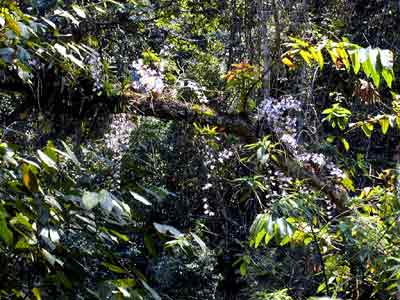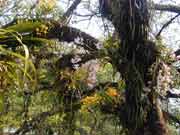 |
|
Garden in the Air |
|

|
“Garden in the Air” sometimes is called “garden on top of trees”, and it refers to the phenomenon that there are many aerial and climbing plants on the aboveground parts of some plants. These kinds of gardens appear in all forests where the environment is humid. In the rain forest, since the environment is hot and humid, such serial and climbing plant varieties are many, and their5 numbers are huge too. The plant communities in the rain forests are generally as tall as 30 to 40 meters, the highest ones could be as tall as 70-80 meters, and could be divided into three to four layers according to the height of the trees. In such circumstance, it has larger space capacity than other forests, and this environment also provides more footholds for serial and climbing plants. Because of these reasons, gardens in the air could be seen everywhere in the rain forests; and they are especially colorful and interesting.
The interesting part of the gardens in the air in the rain forest of Xishuangbanna lies in that it has abundant varieties. There usually many varieties of orchids, Wax Plant
(Hoya spp.) growing on the tree trunks, branches and the evergreen leaves; and many varieties of Staghorn Fern (Platycerium wallichii), such as
Neottopteris nidus and Pseudodrynaria coronans etc,
as well as many Centipede Tonga Vine (Epipremnum pinnatum), Ceriman (Monstera deliciosa) and
Rhaphidophora decursiva and various mosses and lichens etc. Particularly in the transition period from the dry season to rainy season, many aerial orchids, such as
Dendrobium densiflorum, D. chrysotoxum, D. primulinum, Vanda (Vanda coerulea), would begin to bloom in all colors on the tree trunks and branches
, which are quite poetic and dramatic.
 |
|
various epiphytic orchids on trees |
Adnascent plants all have sponge-like aerial roots, which stick to the trunks or branches of trees, or hang in the air; they could effectively absorb the water and dissociated nitrogen in the air; their plants have the features such as big in branches or leaves, which could store more water and nutrition; some of them have thick leaves, some of them have hide-like leaves or wax leaves, which could prevent evaporation of water. Some of them grow in groups and could accept more water or accumulate a certain amount of humus, and they could also absorb nutrition flowing along the trunks and branches or in the roots or even nutrition dissolved in soil. In general, all the plants in the “gardens in the air” have the capacity to grow under conditions without soil and to hang on other trees, and their growth and development are not affected by the lack of water and nutrition. Some trees, such as Double Hea Tree
(Bischofia javanica) and Lagerstroemia tomentosa, have rough barks, where there is more leather acid, and could provide various adnascent and climbing plants with better living environments; therefore, they have more friends and are often gorgeously dressed.
Adnascent plants regard the trunks, branches and leaves they parasitizes on as their inhabited places, and they don’t strive for water and nutrition with them; besides having some impact on the sunlight of these plants, they cause no harm to the plants they inhabited on. Then, what good could
adnascent plants bring forth for the plants they inhabit on? Such researches are less, and human beings know very little about it on. Maybe the growth and withering of
adnascent plants could create conditions for the plants they inhabited on to improve their water and nutrition conditions; and maybe the insects attracted by them when they are in blossom could bring forth opportunities for the pollination of the plants they inhabit on.
 
|